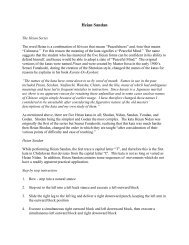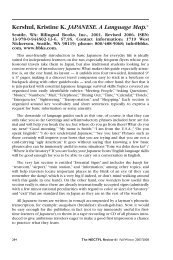selected paintings - Dickinson College
selected paintings - Dickinson College
selected paintings - Dickinson College
You also want an ePaper? Increase the reach of your titles
YUMPU automatically turns print PDFs into web optimized ePapers that Google loves.
5<br />
Rooftops and Cathedral, Basel, n.d.<br />
Oil on wood, 15 1/5 x 18 1/3 in. (38.6 x 46.6 cm)<br />
Signed: l.l.: Quincy<br />
Exhibited: Spirit of the Past: The Paintings of Edmund Quincy, 1903-1997 (New<br />
York: Hirschl & Adler Galleries, 2000); Exhibition of Paintings by<br />
Edmund Quincy (Wellesley, MA: Wellesley <strong>College</strong> Art Museum, 1945).<br />
Published: Zachary D. Ross, Spirit of the Past: The Paintings of Edmund Quincy,<br />
1903-1997 exh. cat. (New York: Hirschl & Adler Galleries, 2000), 11,<br />
38, cat. 42; Exhibition of Paintings by Edmund Quincy (Wellesley, MA:<br />
Wellesley <strong>College</strong> Art Museum, 1945), n.p.<br />
Quincy’s Rooftops and Cathedral, Basel stands apart from his<br />
other European <strong>paintings</strong>. Most of his <strong>paintings</strong> of European<br />
scenes show Southern Europe and, as Zachary Ross remarked,<br />
“thus tend to be more colorful than his grittier Boston <strong>paintings</strong>.”<br />
1 This painting is an exception. The surface is clearly “gritty,”<br />
and it does not have the same clear, bright palette that<br />
Quincy used in such <strong>paintings</strong> as A Windy Day, Paris or Rural<br />
Landscape with Distant Church. This difference in palette and<br />
surface may be attributed to one of Quincy’s periods studying in<br />
Paris, which began in 1927 at the Academie Colorossi. 2 One<br />
critic noticed the effect the texture of Quincy’s <strong>paintings</strong> had<br />
upon him: “With a cosmopolitan breadth of view, he has<br />
absorbed the best of French influence.” 3 Barbara Weinberg discussed<br />
this French influence upon American Impressionists: “As<br />
students of Paris…some of these Americans were exposed to the<br />
French Impressionists’ direct, rapidly rendered, rough-textured,<br />
light-saturated portrayals of modern life.” 4 The Christian Science<br />
Monitor mentioned the “warm red glow of old bricks and tiled<br />
housetops” of this painting, demonstrating the color scheme. 5<br />
In Rooftops and Cathedral, Basel, Quincy combined his rich,<br />
warm palette (seen in Quincy’s work such as the buildings of his<br />
Industrial Quarter) and a thick, textured surface to create a specific<br />
atmosphere in his rendering of a scene of urban rooftops<br />
and a cathedral.<br />
Quincy incorporated the “impressionist” ideal of “rejecting<br />
conventional detail” by not depicting every shingle from the<br />
roofs, every relief on the cathedral’s walls, every change in texture<br />
on the structures. 6 Rather, he depicted a scene focusing<br />
upon the tops of these structures, with an emphasis upon tone<br />
and color. The compositional layout looks similar to a photograph<br />
that might have been taken from a window from an<br />
upper story of an apartment building. This “photographic”<br />
approach is typical in many Impressionist <strong>paintings</strong>. Numerous<br />
Impressionist artists from Degas (in, for example, The Rehearsal<br />
[1873-1875]) to William Merrit Chase (in At the Seaside<br />
[1892]) arranged their compositions so that they did not look<br />
staged, and instead appeared to be scenes that the artist spontaneously<br />
decided to depict. Margaretta Lovell noted in her discussion<br />
of an Impressionist exhibition of cityscapes that, “while<br />
the principal buildings were generously garnished with elaborate<br />
sculptural programs, it was for the most part the overall urban<br />
14<br />
ensemble that the painters recorded and celebrated.” 7 Daniele<br />
Devynck once said of Toulouse-Lautrec, “The color scheme is<br />
entirely defined, with reds, purples, and violets that create a<br />
grave, subtle harmony.” 8 This is particularly obvious in Lautrec’s<br />
<strong>paintings</strong> of the Moulin Rouge (1890), where Lautrec incorporated<br />
a vivid color palette to unify the smoky air and the latenight<br />
crawlers of the venue. Likewise, Quincy’s warm palette of<br />
rich reds and lush browns unifies the rooftops with the cathedral.<br />
In this unity, Quincy has created a peaceful microcosm: he<br />
is not concerned with the noisy streets of Basel, nor the activities<br />
in the homes. Zachary Ross noted, “His pictures are often<br />
careful studies of the quiet sides of the city.” Quincy’s focus is<br />
solely upon the “harmony” between the rooftops and the cathedral<br />
and the visual world that these objects create.<br />
In his depiction of this microcosm, Quincy suggests that he<br />
is portraying a moment in this world rather than a permanent<br />
image of these rooftops and this cathedral. Quincy’s use of light<br />
in the painting shows that he is portraying a particular time of<br />
day, most likely sunrise or sunset, as indicated by the juxtaposition<br />
of highlighted areas on one side of the buildings and deep<br />
shadows on the other sides. Zachary Ross noticed this attention<br />
to detail when he noted Quincy’s “clear portrayal of sky and<br />
sunlight.” 10 Henri Luc Gerstein noticed a similar approach by<br />
Maximilien Luce in his portrayal of Notre Dame Cathedral<br />
(1899): “The effect of weather, time of day, and movement<br />
interested him more than the activities of the people on the<br />
bridges, quays, and streets.” 11 Quincy further relays that this is a<br />
transient moment in the sky by framing the structures: clouds<br />
hover in some areas while powder blue sky pokes out in others,<br />
generating a moment of changing weather. This combination of<br />
temporal changes (be it sunrise or sunset), along with the pending<br />
transformation of weather, create an image of a particular<br />
moment. Juliet Wilson-Bureau described this concept of transience<br />
when she described Monet’s Rouen Cathedral as having an<br />
“evocation of fleeting changes in light and atmosphere.” 12<br />
Quincy’s Rooftops and Cathedral, Basel presents this portion<br />
of Basel as a world unto itself. Maximilien Luce had a similar<br />
goal when painting Notre Dame. He wrote to a friend, “I’m still<br />
grinding away at Notre Dame. I would like to do ceremonies,<br />
marriages, people coming and going, in a word Paris.” 13 In<br />
Quincy’s painting, the viewer sees only the tops of the structures<br />
and the sky. Quincy’s focus upon color in order to unify the<br />
scene along with his allusions to time and atmosphere, make for<br />
a very specific portrait of this cityscape. The viewer is immersed<br />
in the European architecture, the space of this quiet microcosm<br />
above the streets, and the air that permeates this area. Theodore<br />
Roosevelt had a comparable reaction when he visited the<br />
World’s Columbian Exposition, an Impressionist collection of<br />
cityscapes. When asked what impressed him most, he easily<br />
replied, “The buildings, of course.” 14<br />
Anna Alston Donnelly






